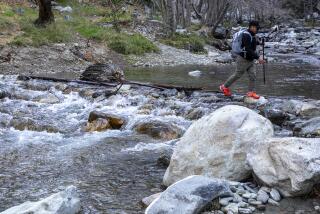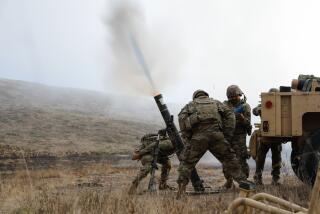Tread (and bike) carefully
- Share via
MONTEREY, CALIF. — As a relatively new convert to mountain biking, I’m already familiar with the hazards of this pastime.
In my short two or three years as an enthusiast, I’ve been a victim of protruding roots, tire-swallowing sand pits, teeth-jarring washboard trails and slick, half-buried rocks that have sabotaged my good times like rain on a picnic.
But I never thought I would have to worry about Claymore mines, hand grenades, 3-inch antitank rifle grenades and 81-millimeter mortars.
These and other military explosives are potential -- although rare -- hazards on the hiking and biking trails of the Ft. Ord Public Lands, a 7,200-acre recreational area about 10 miles east of Monterey.
Before it closed in 1994, Ft. Ord was one of the nation’s largest military training facilities, preparing soldiers for the two world wars, as well as Korea and Vietnam. The Bureau of Land Management took over more than 7,200 acres of the old military base in 1996 and threw open the gates to more than 80 miles of hiking and mountain-biking trails.
But there was one hitch: The Army had yet to find and remove every last ordnance from the scenic, oak-studded rolling hills. We are talking about rockets, mortars, mines, grenades and other weapons of demolition.
Fast forward to me, in early February, mounting a hardtail bike (no rear suspension) at a trail head on the western borders of the old military base. As I prepared for a day of riding, I pulled a safety warning pamphlet out of a box marked “trail maps” and scanned the photos of World War II- and Vietnam-era weapons.
“If you find an object that resembles those shown in the photograph -- don’t touch it,” the pamphlet said.
No kidding.
And I used to worry about running into protruding boulders, ocotillo plants and rabid pit bulls.
But after two days of riding at Ft. Ord, I encountered no antipersonnel weapons. I rode like a madman over the emerald hills, etched in a spider-web network of single-track trails, fire roads and paved streets. And, yes, I had a real blast. (Cue the rimshot.)
It’s no wonder that the Ft. Ord Public Lands hosts the annual Sea Otter Classic (this year, April 16 to 19), a biking competition and festival that draws more than 50,000 athletes and fans from around the world.
On both days of my visit, I started with a muscle-burning grind up steep hills, blanketed in green grass, chaparral and brush oak. Once at the summit, I had to stop to admire the gorgeous views of gently rolling hills stretching to the sea to the west and dropping toward the fertile fields of the Salinas Valley to the east. Moss hung on the craggy oak trees like tinsel on a Christmas tree. Overhead, turkey vultures and red-tailed hawks cut figure eights in the partly cloudy sky.
The real fun began at the top. I swooped down the smooth, hard-packed dirt trails, over whoop-de-dos that lifted me off the bike pedals, then dropped me hard on my seat. The trails curved left and right like a slithering snake, around oak trees and shrubs. Blind curves were as common as chaparral. I flirted with disaster but escaped riding headlong into another biker or hiker. Because the park has more than 80 miles of roads and trails, the chances of colliding with another guest are relatively low.
I was having so much fun I didn’t think twice about the potential for leftover military hardware.
A few days later, I spoke to Eric Morgan, the Ft. Ord manager for BLM, who said park staff occasionally found old bombs, mines and other Army surplus. But, so far, no one had been hurt, he said, and the Army continues to clear out left-behind ordnance. But he said bikers and hikers should have nothing to worry about as long as they stay away from the adjacent former range area encircled by barbed and concertina wire. That land -- about 7,500 acres -- will be turned over to the BLM once the Army removes all the hidden munitions, a process that could take up to 10 years.
Just stay on the marked trails and you should be fine, Morgan said.
Good advice, but while racing around the Ft. Ord land I was constantly having to stop and check my map to keep from getting lost. The single-track trails crisscross the hills like a maze. Several times I found I had detoured off my planned route and had to double back to get on track.
At the Creekside Trailhead, near the intersection of California Highway 68 and Reservation Road, I met a local cyclist who suggested a 5-mile route that started at the northeast end of the park, climbed about 500 feet, then circled back along a long downhill stretch.
“On that last stretch you can really bomb down the hill,” he said.
Speaking of bombs, I asked, have you ever come across any old ordnance?
Not yet, he said.
I strapped on my helmet and began to follow his suggested route but discovered that the trail, dubbed by locals the Hobo Trail, sandy and hard to climb at the start.
Farther into the park, however, I plummeted down the fast, narrow Goat Trail and came close to flying off my bike at several spots.
I reached the trail head out of breath and sweating, but grinning like the Cheshire Cat.
I left hoping this was the start of a new American trend: Shuttered military bases are converted to hiking and mountain biking playgrounds.
Make fun, not war.
--
--
BEGIN TEXT OF INFOBOX
The best way to Ft. Ord
Directions: From California Highway 1 in Monterey, take California 68 north for about 13 miles, then turn left on Reservation Road and follow the signs to the Ft. Ord Public Lands to the Creekside Trailhead.
Admission: Free
Hours: 7 a.m. to 7 p.m.
More to Read
Sign up for The Wild
We’ll help you find the best places to hike, bike and run, as well as the perfect silent spots for meditation and yoga.
You may occasionally receive promotional content from the Los Angeles Times.







